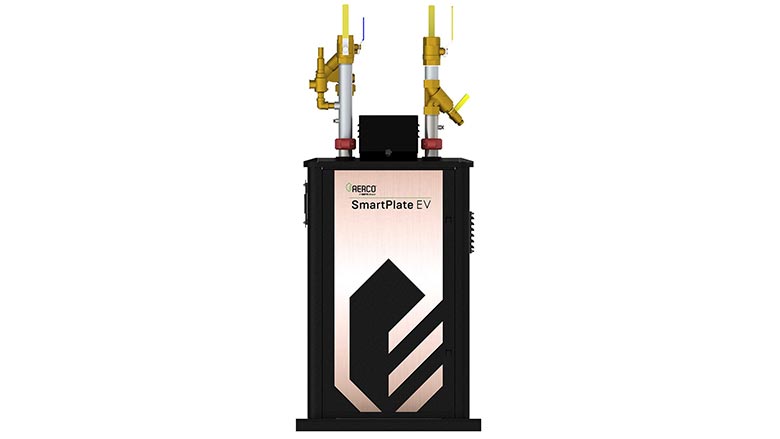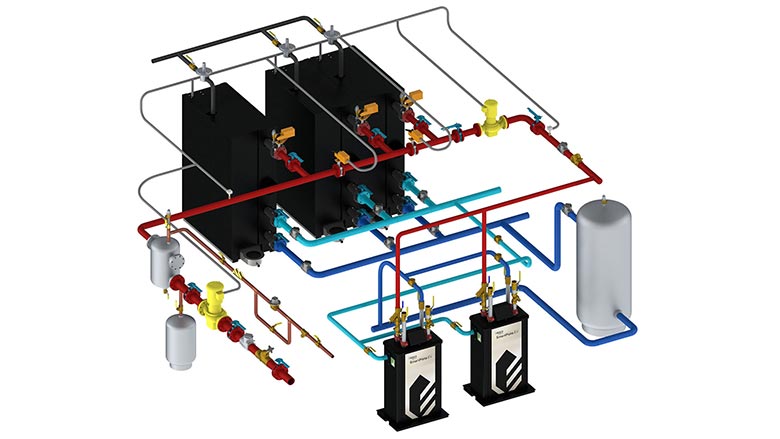The benefits of indirect water heating systems are well-known throughout the industry and include system versatility and aiding in electrification to lower utility costs (if it is used in co-generation environments). Other advantages are higher operating efficiency, lower maintenance costs and longer system life.
The question is, “How do I realize those benefits to achieve optimal ROI?”
Importance of properly sizing systems
You can start with properly sizing the system. When sizing equipment, a close look at all factors must be done. It goes beyond determining the peak space heating (SH) load combined with the peak direct hot water (DHW) load. Engineers and contractors can refer to the 2019 ASHRAE Handbook — HVAC Applications, Chapter 51 for guidelines to help correctly size a system.
As outlined in the handbook, it is important to establish hot water demand and usage per hour when considering system design. Total demand determines the required capacity of the indirect water heater. Hourly usage is a measurement of demand. If there are certain hours when demand for hot water is especially high, the total heater capacity may be excessive. Common examples of such scenarios include hotels, apartment buildings and dormitories. In these cases, it is often practical to fill a hot water tank before peak hours to reduce the required heater capacity.
Seasonality must also be considered. An indirect water heater designed for the hottest primary water temperatures may not have the capacity to meet the demand when the primary water temperatures are reduced. Thus, it is important to design the indirect water heaters so that they provide the design capacity at the lowest design primary water temperatures. Design capacity is achieved during the warmest days and greater capacity during coldest days, if an outdoor reset schedule is used to control primary water temperature.
Single or double wall?
Equipment capacity is an important evaluation criterion, but it is not the only one. Another consideration is the design of the water heater, including selecting a single- or double-wall water heater.
A single wallwater heater is designed with only one metal wall between the heating fluid and heated fluid. Double wall units have two metal walls and an air gap between them. They operate at a slightly lower efficiency rate and have a significantly higher price tag due to a more complex design.
A double wall water heater is worth the financial trade-offs because of its distinct safety advantages. In the event of a leak, a double wall water heater prevents the heating fluid from mixing with heated fluid. The safety benefits are why most jurisdictions in the United States mandate a double wall water heater, taking the decision out of the engineers’ and/or contractors’ hands.
Mechanical room considerations
Physical space occupied by the system is a consideration during installation. This is especially true in small mechanical rooms, which is often the case in older buildings. To compensate, indirect water heaters can be placed directly next to the boilers to create a smaller footprint.
Most water heaters used in an indirect system, such as the one shown in Figure 1, have a small footprint. Further helping create a small footprint is that some water heaters, including the one shown, do not require gas lines or ventilation piping.
FIGURE 1
 Small-footprint water heaters are commonly used in indirect systems.
Small-footprint water heaters are commonly used in indirect systems.
When implementing the system into the mechanical room, three configurations are available:
- Single temperature — In this design, the system must be large enough to generate sufficient water and heat, as the boiler setpoint is used for SH and DHW. Typically, simple standard boiler controls are used;
- Temperature boost — These systems are more efficient than a single temperature system, as the boiler setpoint automatically rises to meet DHW demand. Boiler temperature is lower when only SH is necessary (there is no DHW demand present). This higher level of operation is achieved, in part, through the integration of advanced intelligent controls into the boiler; and
- Two Loop —The most efficient approach is to design twoindependent systems with unique setpoints. One loop operates a boiler or group of boilers dedicated to DHW and other units are for outdoor reset based on a schedule. In this two-loop system, the DHW demand will not raise the SH setpoint or pause the outdoor reset schedule.
Often, a swing boiler is used in this design. A motorized swing valve acts as a physical barrier between SH and DHW boiler loops, allowing a unique boiler water temperature for each. Piped between the pair of swing valves is a swing boiler that switches between SH and DHW applications according to demand, providing redundancy to both plants (Figure 2).
FIGURE 2
 An example of a swing valve system.
An example of a swing valve system.
Maximizing system performance
There are other factors to consider for indirect water heater systems to operate at high efficiency. Approach temperature and pressure drops are often overlooked even though they can have a significant impact.
Approach temperature is the difference between primary water temperature and DHW setpoint. Indirect DHW equipment may need a higher setpoint than SH to satisfy the demand in either a single temperature or temperature boost configuration. Approach temperatures are particularly important during a retrofit project that converts from a steam or boiler system to a heat pump system. The reason is that heat pump systems often have a lower supply temperature.
There are two causes of pressure drops.The heat exchanger requires a certain level of primary water flow to meet peak DHW demand. As a result, indirect water heaters can have a high-pressure drop through the heat exchanger to the control valve. The pressure drop of the indirect heater must be specified during sizing to ensure that the correct pump is selected to allow enough flow at the pressure drop.
The second pressure drop also revolves around DHW demand.Calculating DHW demand in an indirect system is done in the same manner as other water heater configurations. Fixtures, building demand studies, or matching like-for-like are the most common techniques. There is typically a smaller pressure drop on the DHW side, as it does not have a control valve, which is common on the primary side. Engineers must take this into account when designing the system.
Conclusion
Indirect water heating systems can bring multiple operating and financial benefits to SH and DHW applications in retrofit and new construction. Careful selection of equipment, optimizing designs, and properly sizing the system will help achieve the best possible ROI.


